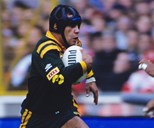It looks like you may be using adblocking software to view this site.
Many features on the site, such as video playback, may not work properly when using adblocking software.
Please whitelist our domain or disable your adblocker to access all features and videos.
As Steve Renouf takes his place in the Hall of Fame, we turn the clock back to look at how overcame diabetes to become one of the game's best centres with this column penned by the Broncos, Maroons and Kangaroos great in 2018.
When I look back on my career in rugby league one of the things I am most proud of is that I beat a killer disease to lead a healthy and active life.
I hope my story can be an inspiration to the 1.7 million Australians that live with diabetes.
In 1992 we won the grand final and I was one of eight Broncos in the Australian squad to go to the World Cup. We won the trophy at the iconic Wembley Stadium and a week later we joined the rest of the Brisbane team and won the World Club Challenge against Wigan. I was 22 and having the time of my life.
We headed home and the weight started to just drop off me.
I lost eight kilograms from late November until we got back to training in January. There are photos of me from back then where my eyes are sunken back in my head. I was in the gym and I had no energy. I couldn't do the sets with five-kilo weights.
I knew something was wrong and thought I might have had cancer.
That's when I saw the club doctor Peter Friis and had a blood test. He called me in and told me I had type-1 diabetes. Initially, I was devastated. Was my career over?
Peter's message to me was that if I looked after myself I could still have a successful footy career but he also warned me that if I didn't, it could all go downhill very quickly.
It looks like you may be using adblocking software to view this site.
Many features on the site, such as video playback, may not work properly when using adblocking software.
Please whitelist our domain or disable your adblocker to access all features and videos.
Renouf: Honour to be on Hall of Fame list
Rapid weight loss and feeling weak are symptoms of type-1 diabetes. I had lost a lot of muscle bulk but within a month or so I had put that back on and got my energy back, just by looking after myself.
I didn't think I would be able to start the 1993 season but I did. I had to have needles four times a day and testing about six times a day with blood glucose finger-prick tests.
Back then we were injecting insulin but now we have an insulin pump that sits under your skin that you change every three days.
I had to explain everything to my Broncos teammates about the symptoms to look out for and what are known as "hypos", where your blood glucose level drops low and you have a feeling like you are weak with hunger.

They were so good to me. They didn't treat me any different and they were quick to pick up if I was having a hypo.
Last week I was honoured to be named in a 25-man list to possibly be one of six players to go into the NRL's Hall of Fame.
It is a great thing that the performances of past players have been recognised in this way and I was stoked to see my former Broncos teammates Gorden Tallis, Petero Civoniceva and Kevin Walters also acknowledged.
I do get emotional when I look back at my time at the Broncos playing under Wayne Bennett with all my teammates, and when I think about what I had to overcome to do it.
I played my entire career from the age of 22 to 31 with type-1 diabetes because I was strict about doing everything my doctor and specialists told me. Untreated, it is one of the main causes of death in Australia, but I am 48 this year and still have no complications, touch wood.
Laid bare: Renouf, racism and rugby league
My four boys have type-1 diabetes as well. I get a lot of parents come up to me and ask me about their child being diagnosed. It is shattering.
I was shattered when I found out about myself, but to find out your two-year-old has it is even tougher as a parent. You can feel isolated and you worry about having to give your kids needles four times a day and blood glucose tests with finger pricks.
My message to parents is it is not all doom and gloom if you get educated.
I'll never forget when Dr Friis told me after that diagnosis about how I could turn it all around and still play for the Broncos, if I was disciplined. It is a vital lesson.
You can have type-1 diabetes and lead a successful and healthy life. I'm living proof.


